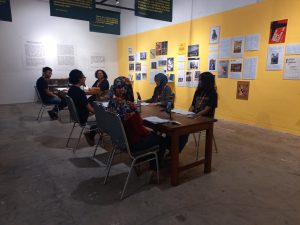The air was quite hot when several media crews visited the Yogyakarta Cultural Park building on Tuesday (5/10). 12 journalists took part in the preview exhibition series this time, which was a series of Biennale Jogja XVI Equator #6 2021. Guided by Alia Swastika and the guide sitter, they seemed enthusiastic about observing the Archive Exhibition program for the decade of the Biennale Jogja.
In this exhibition, there are six researchers involved: Karen Hardini and Gladhys Elliona explored the interconnection of the socio-cultural context of the equator; Duls Rumbawa and Ripase Purba discuss the global political context that influences equatorial geopolitics; Tomi Firdaus and Arlingga Nugroho discussed the decolonization theme.
“This exhibition shows biennale-making’s critical view to compete with western art discourse,” Tomi said as he explained “The Game of Archive” Exhibition’s background when we talked about the research process.
Tomi Firdaus and Arlingga Nugroho, who are members of Kelompok Tiga, have seen the movement of Decolonization during the Biennale Jogja Equator since 2011.
In one corner of the yellow showroom, Arlingga and Tomi presented documentation of posters, articles, and photos of the Biennale outside of Jogja, most of which were formed on the discourse of abolition of colony. The display also includes some books presented with a glass case that allows visitors to closely observe the archives.

Para peneliti Pameran Arsip Biennale Jogja XVI Equator #6 membaca hasil riset mereka.
“The idea of decolonization can be traced to the post-colonial Southern Global Biennale. There, are names such as The São Paulo Biennial (Brazil), Havana Biennial (Cuba), Sharjah Biennial (United Arab Emirates), Kochi-Mozhiris Biennale (India), and The Lagos Biennale (Nigeria),” said Arlingga Nugroho.
“But it’s a bit different from the biennales at the Singapore Biennale (Singapore) and the Bangkok Art Biennale (Thailand). They have a high passion for following in the footsteps of international art exhibitions with Western packaging,” added Tomi, who tried to conclude the final results of the research, as well as the form of presentation.
Around 01.00 p.m, while facing the gadget to make a self-recording with other researchers, Tomi and Arlingga briefly explained their findings.
After listening to the research team’s explanation, I had to go to the Jogja National Museum. Artwork needs a break, but not today.